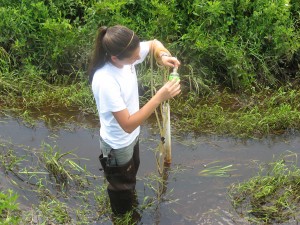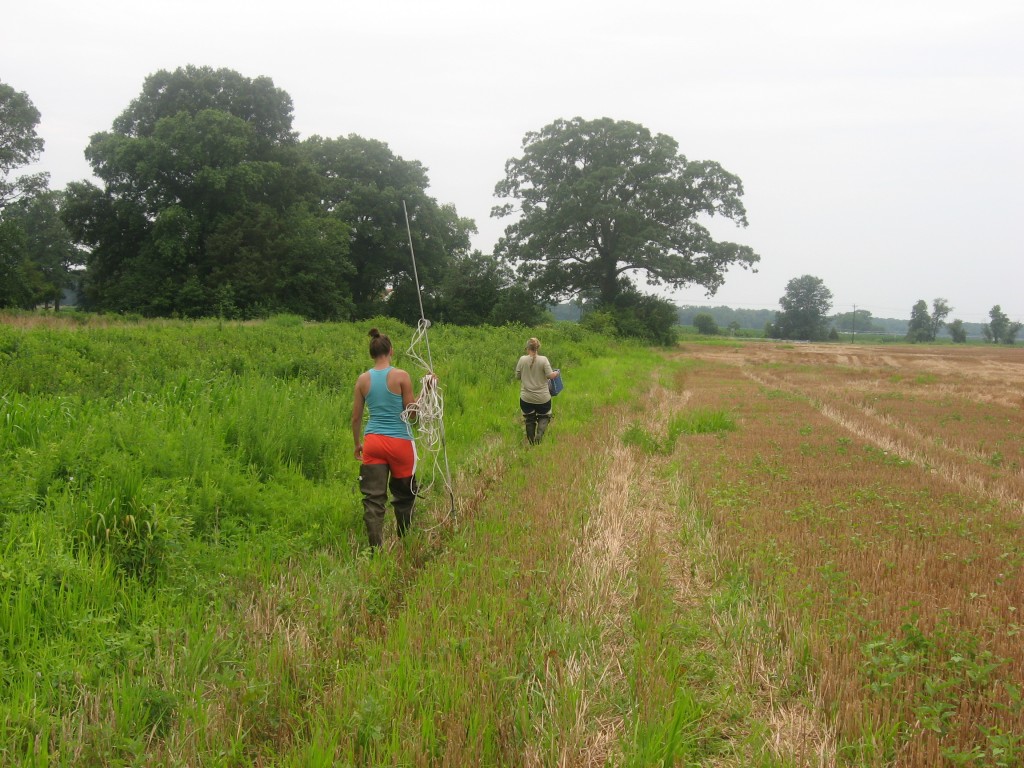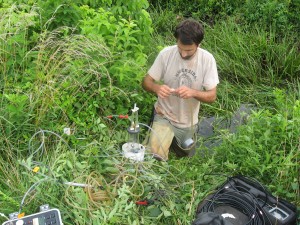By Katie Sinclair
The nutrient lab is still plagued by the mystery of the missing nitrogen. More nitrogen enters the watershed than exits it, and the question remains: Why?
How much nitrogen makes it to the bay can have huge impacts on the water quality and bay health. The Choptank watershed, in a farm-heavy area, has much lower levels of nitrogen in stream water than expected. As farmers add fertilizer to their crops, some nitrogen gets taken up by the plants, and the rest washes away into the watershed , eventually reaching the Chesapeake Bay. Of the nitrogen that is added as fertilizer, only 20 to 30 percent of it is accounted for.
In a narrow, slow-moving stream in the Choptank watershed, fondly nicknamed “Pizza Branch” (due to its proximity to a lone pizza joint puzzlingly located in this predominantly farming area), researchers working under Tom Jordan, Principal investigator of the nutrient lab at SERC, are using different methods to help determine what’s happening to the nitrogen. The project is a joint effort between SERC and Tom Fisher’s lab at the Horn Point Laboratory of the University of Maryland.
Researchers brave high heat, humidity, and voracious mosquitoes to take water samples, a process that can take all day. While taking water from a stream may seem like a straightforward undertaking, the true complexity comes through in the lab, where analysis of microscopic dissolved compounds can reveal the secrets of a watershed.
“It’s a fun challenge to go all over a stream and take samples and bring them back to the lab, to discover things you can’t see with your eyes,” said Jordan.

SERC intern Alison Chin uses a piezometer–a long tube that reaches into the stream bottom–to access groundwater
One culprit for the missing nitrogen may be denitrifying bacteria that live in streams and soil. In the absence of oxygen, these bacteria turn nitrate into N2 as they respire. Nitrate is a nutrient that can be used by organisms and is one of the sources of “nutrient pollution” that can lead to harmful algal blooms. N2 is a harmless gas.
However, 78 percent of the atmosphere happens to be N2, so measuring the exact amount leaving a stream is challenging to say the least. To measure the amount of N2 being released, scientists keep track of the concentrations of argon and radon.
Argon is a gas that occurs naturally in the atmosphere, so the amount of argon in a stream should correlate with the amount of atmospheric nitrogen—if there’s more N2 than expected, it means N2 is entering the system apart from the atmosphere. Likewise, measuring radon, a radioactive gas that is found naturally underground but does not exist in the atmosphere, can help determine how fast gas from a stream exchanges with the atmosphere. SERC intern Alison Chin has been taking and comparing radon samples from different parts of the Choptank, hoping to see if there’s a connection between radon and other factors like groundwater or stream flow.
Besides looking for nitrogen, researchers also inject a chemical compound called bromide to figure out how much groundwater is entering the stream. As a rule, the more groundwater that enters, the lower the concentration of bromide ions will be downstream. Researchers take samples at several points in the stream every 15 minutes over the course of six hours—a long time to spend out in the sun in the hot Maryland summer, but it’s a sweaty sacrifice that scientists are willing to make in order to better understand stream dynamics.
Researchers also sample a host of other ions and compounds. Sulfate, nitrate, phosphate and other chemicals need to be measured back at the lab. Because bacteria that live in the stream are still active, samples must be chilled to prevent the bacteria from changing the nutrient concentrations. A cooler well-stocked with ice is invaluable when temperatures reach 90-plus degrees.
“It may seem like we’re just taking a bunch of water samples, but it really comes together to give a complete picture of the watershed,” said John Gardner, a graduate student from the Horn Point Laboratory who is basing his thesis on the project.
Through hot and humid days, the nutrient lab treks on. By focusing on stream and groundwater chemistry, they can give us a better idea of how nutrients enter and interact in a stream system, and ultimately how those nutrients enter the Chesapeake Bay. Research done at the humble “Pizza Branch” may one day answer the age-old question of where the nitrogen goes—or at least tell them how much is escaping through stream water as N2 gas made by some helpful bacteria.
The participants in the project are grateful to the land owners who have kindly allowed access for sampling.
Read More: Hunt for a Missing Nutrient Part I




is it possible that the plants around the nitrogen spikes may be excreting their unused nitrogen into the watershed?